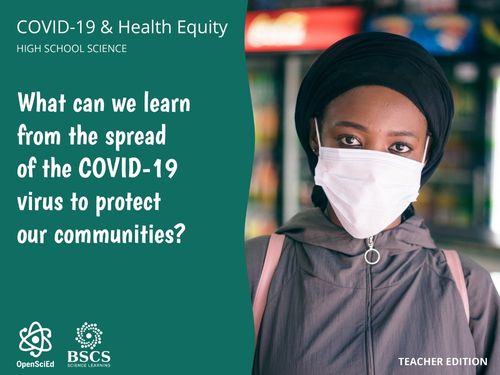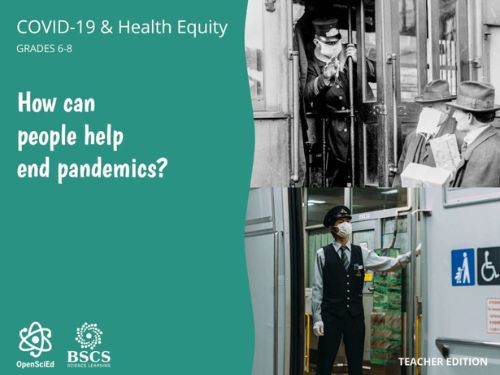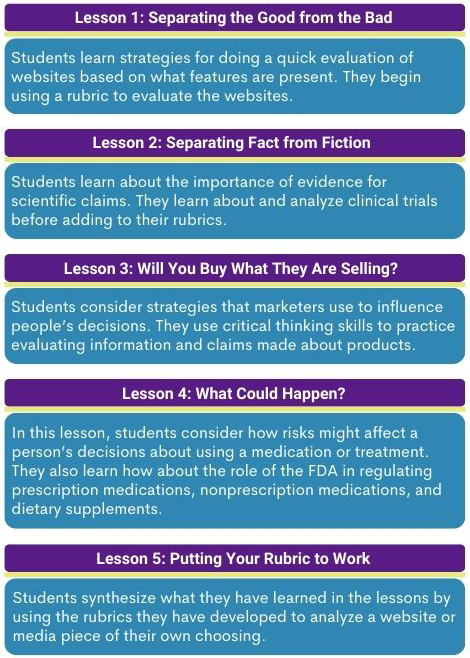This 6th grade unit on thermal energy engages students in a design challenge to create a cup that keeps drinks cold longer. They identify the features that make some cups better at keeping drinks cold, and they construct their own models to explain how those features prevent the transfer of thermal energy.
In this unit, students build an understanding of energy transfer within and between materials based on a particle model, and they work on the practices of modeling, conducting investigations, constructing explanations, arguing from evidence, and designing solutions.
Thermal Energy is aligned to the Next Generation Science Standards and is freely available for download. This unit is part of the OpenSciEd middle school science program. BSCS Science Learning lead a consortium of organizations and science education experts in the development of this three-year program for grades 6-8.
This 7th grade unit on metabolic reactions in the human body engages students in an investigation of a real case study of M’Kenna, a 13-year-old girl, who reported some alarming medical symptoms to her doctor. Her case sparks questions and ideas for investigations to figure out which parts of M’Kenna’s body are functioning differently from a healthy person’s system and why. Through the work of investigating M’Kenna’s symptoms, the class constructs a model to explain what happens to food after it enters people’s bodies, and they use it to explain M’Kenna’s symptoms.
In this unit, students build an understanding of how body systems interact to process food and use the energy stored within it. They work on the practices of developing models, interpreting data, and arguing from evidence.
Metabolic Reactions is aligned to the Next Generation Science Standards and is freely available for download. This unit is part of the OpenSciEd middle school science program. BSCS Science Learning lead a consortium of organizations and science education experts in the development of this three-year program for grades 6-8.
In this 8th grade unit, students investigate how sounds can cause objects at a distance to move. Motivated by a video of windows shaking when a truck outside plays loud music, students investigate what happens when an object makes sound. Over the course of the unit, they build a model that describes what happens when sounds are created that can explain the shaking windows and other examples of sounds causing objects to move.
In this unit, students use a particle model of air to build an understanding of how sounds move that explains the effect of sounds on other objects. They work on the practices of planning and conducting investigations, using mathematical and computational thinking, and evidence-based argumentation.
Sound Waves is aligned to the Next Generation Science Standards and is freely available for download. This unit is part of the OpenSciEd middle school science program. BSCS Science Learning lead a consortium of organizations and science education experts in the development of this three-year program for grades 6-8.
How can people help end pandemics? Educators and students across the country are investigating important questions like this in the classroom (in-person and online!) while navigating COVID-19 in their own daily lives.
BSCS Science Learning created free units on COVID-19 & Health Equity for middle and high school. In these units, teachers and students work together to make sense of the pandemic and how it disproportionately affects underserved communities by engaging in science inquiry and social and emotional learning.
BSCS worked closely with OpenSciEd and experts to develop the multidisciplinary middle and high school units. OpenSciEd distributes these units along with units for grades K–5.
High School Science Unit

The high school unit focuses on the question, “What can we learn from the spread of the COVID-19 virus to protect our communities? ” It is designed to teach students about the COVID-19 pandemic, transmission of the COVID-19 virus, and the impacts of the pandemic on communities, especially communities of color.
The unit employs an inquiry-based approach, and is designed for 14 class periods of instruction, with several optional extensions. There are four broad areas of learning goals targeted in this unit:
- virus transmission between people and communities,
- mitigation strategies and using probabilities to explain how we can lower the chance of transmitting the virus between people and across communities,
- understanding disproportionate impacts on communities and the policies and practices that lead to those impacts, and finally,
- development of two social emotional competencies—self awareness and social awareness.
The high school science unit was developed in a partnership between BSCS Science Learning and current classroom teachers from across the country. Epidemiologists, public health experts, equity and antiracist education experts, community groups, as well as social-emotional learning experts contributed to the material development.
Middle School Science Unit

The middle school unit focuses on the question, “How can people help end pandemics?” It is designed to teach students about the COVID-19 pandemic, transmission of the COVID-19 virus, and the impacts of the pandemic on communities.
The unit employs an inquiry-based approach and is designed for 15 class periods of instruction, with optional extensions. Students will study the COVID-19 pandemic in light of historical pandemics to develop two social emotional competencies, self awareness and social awareness, and to build an understanding of the following key concepts:
- how the COVID-19 virus spreads from person to person and through communities,
- how strategies to reduce transmission of COVID-19 work, and
- how the actions of individuals can help to end pandemics.
The middle school science unit was developed in a partnership between BSCS Science Learning and current classroom teachers from across the country. Epidemiologists, public health experts, equity and antiracist education experts, community groups, as well as social-emotional learning experts contributed to the material development.
Funding for the COVID-19 & Health Equity Units was provided by a generous donor, who prefers to remain anonymous.
This is an archived educational resource page.
BSCS has determined that we can no longer recommend the use of this resource because it is out of date or we are no longer able to provide support for it. We are continuing to make this page and the resources linked to it available so that members of the educational community can review and learn from it.
How many times have you heard or read a story about a new scientific advancement? Every day, we get new information about health and science. It is on websites, social media, television, and newspapers. It can be hard to know what to believe. Sometimes, it may sound like a great advancement or something that is too good to be true. Other times, it seems like it is completely opposite to other information that you have heard.
How can we know what is valid?
BSCS Science Learning has released new curriculum modules for middle school and high school students with this challenge in mind. The goal of these freely available materials is to help students learn strategies that they can use to evaluate the health-related information that they see or hear in the media. Through the five lessons, students gain experience in finding, analyzing, and communicating about health information. Although the modules focus on health-related examples, the strategies they learn can be applied to many areas of life that require good decision-making skills.
Overview of Lessons

This project was supported by the Office of the Director, National Institutes of Health under award number R25OD020208. The content is solely the responsibility of the authors and does not necessarily represent the official views of the National Institutes of Health.
This is an archived educational resource page.
BSCS has determined that we can no longer recommend the use of this resource because it is out of date or we are no longer able to provide support for it. We are continuing to make this page and the resources linked to it available so that members of the educational community can review and learn from it.
Allergies affect more than 50 million Americans, and are among the leading causes of chronic disease in the US. One in every 13 children, roughly two students in every classroom, have allergies to food.
To help middle school teachers more effectively teach about food allergies, BSCS Science Learning has developed an online curriculum supplement called Allergies and Scientific Inquiry. Students using this multimedia resource learn how to distinguish food allergies from other negative food reactions. They explore the role of the immune system in causing allergy symptoms and learn how medical research is contributing to better allergy management.
Lessons engage students in the practices of scientific inquiry, and are aligned to the Next Generation Science Standards. Teachers can access instructions for navigating the classroom lessons once logged into the teacher portal.
Is this the right resource for your classroom? Here’s a sample of what students will learn:
- Allergies involve inappropriate reactions of the immune system.
- Scientific medical diagnosis of food allergies is critical.
- The main management option for people with food allergies is avoidance.
- The management of food allergies is improved if people know how to correctly read food labels.
- Individuals with food allergies should not be stigmatized.
This resource was supported by a grant (R25 A1098674-01) from the National Institute of Allergy and Infectious Diseases.
This is an archived educational resource page.
BSCS has determined that we can no longer recommend the use of this resource because it is out of date or we are no longer able to provide support for it. We are continuing to make this page and the resources linked to it available so that members of the educational community can review and learn from it.
Building upon the success of the BSCS Science: An Inquiry Approach high school program, BSCS Science Learning has developed and field tested* a multidisciplinary science program for middle school students.
BSCS Middle School Science is a standards- and inquiry-based program comprised of four units: Earth/Space Science, Life Science, Physical Science, and Science and Society. Designed for maximum flexibility, the units are grounded by the BSCS 5E Instructional Model and can be adapted for various teaching styles and classroom settings.
The curriculum is available free online for teachers.
*The field test results demonstrated significant content gains across all four units.
This resource was funded by the US Department of Education and the Institute of Education Sciences.
Every day, more than 130 people in the United States die after overdosing on opioids. The misuse of and addiction to opioids is a serious national crisis that affects public health as well as social and economic welfare. While opioid use by teenagers has decreased to historically low levels in some cases, there has been a dramatic increase in vaping. Research is showing that exposure to nicotine, marijuana, or other drugs during adolescence can affect the brain’s function and development on both a short-term and a long-term basis.
BSCS Science Learning has developed a curriculum supplement to teach middle school students about drug abuse and addiction in relevant, real-life contexts. The module—Drug Abuse, Addiction, and the Adolescent Brain—helps students understand how drugs of abuse change the way the brain works and consequently change a person’s thoughts, feelings, and behaviors. A unique aspect of this module is the focus on how drugs of abuse can affect the developing brain of an adolescent differently than they do the adult brain.
This program is freely available and features five classroom lessons with four video segments.
This resource was developed with funding from the National Institute on Drug Abuse (NIDA).
In 2014-15, more than 11,000 people died in an outbreak of Ebola in West Africa. And since August 2018, the Democratic Republic of Congo has been experiencing the second worst outbreak in history, with roughly 2,264 deaths and 3,310 documented cases.
BSCS Science Learning has developed a free resource to educate the public about Ebola. The website—Understanding Ebola Virus Disease—includes an interactive model that allows teachers, students, and community members to actively explore the factors that influence a disease’s spread and mortality rate.
In alignment with the Next Generation Science Standards, the resource addresses selected disciplinary core ideas, science practices, and crosscutting concepts.
This material was developed in partnership with Oregon Public Broadcasting and is based upon work supported by the National Science Foundation under Grant No. DRL-1518346. Any opinions, findings, and conclusions or recommendations expressed in this material are those of the author(s) and do not necessarily reflect the views of the National Science Foundation.
This is an archived educational resource page.
BSCS has determined that we can no longer recommend the use of this resource because it is out of date or we are no longer able to provide support for it. We are continuing to make this page and the resources linked to it available so that members of the educational community can review and learn from it.
Children are naturally inquisitive. That is one of the many reasons why it is important to engage students in science at a young age. With access to a high quality science education, students can channel their curiosities to help make sense of the world around them.
BSCS Science Learning’s elementary program allows preK through grade 5 students to interact like scientists, participating in inquiry-based activities while also developing important reading, writing, and critical-thinking skills. BSCS Science Tracks: Connecting Science & Literacy offers four modules—life science, earth & space science, physical science, and science & technology—for each grade level.
BSCS recently revised two units to align with the Next Generation Science Standards. These units are: Investigating Properties Student Guide and Investigating Ecosystems Student Guide. All units are available for purchase through Kendall Hunt Publishing Company.
